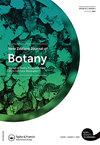A taxonomic, cytological and genetic survey of Japanese knotweed s.l. in New Zealand indicates multiple secondary introductions from Europe and a direct introduction from Japan
IF 1.4
4区 生物学
Q4 PLANT SCIENCES
引用次数: 3
Abstract
ABSTRACT Japanese knotweed sensu lato is a group of invasive plants, including Reynoutria japonica (var. japonica, var. compacta), R. sachalinensis, R. × bohemica, F2s and any backcrosses. Outside of its native East Asia, Japanese knotweed s.l. is an intractable weed, spreading by massive clonal reproduction, and causing significant ecological damage and economic cost. Japanese knotweed s.l. has been naturalised in New Zealand for at least a century and it is now locally abundant, particularly on the West Coast of the South Island, and poses a substantial threat, with large parts of the country being susceptible to colonisation. However, little is known of the taxonomic, cytological and genetic diversity of the clones present in New Zealand, nor of the biogeographical origin of their source populations. In the current study, Japanese knotweed s.l. was sampled from New Zealand, and each specimen characterised in detail using morphological characters, diagnostic microsatellite markers, somatic chromosome counts and PCR-RFLP on three chloroplast regions to create multiprimer haplotypes (MPHs), all of which were compared with pre-existing global databases. On the North Island, Japanese knotweed s.l. is exclusively represented by the notorious female, octoploid var. japonica clone, which is widespread in Europe. While the South Island is more diverse, in addition to R. japonica var. japonica, there is a tetraploid var. compacta clone and several R. × bohemica clones (tetraploid & hexaploid). The majority of these are also of European stock and represent further secondary introductions from the existing adventive range. However, there is also evidence for tetraploid Japanese R. × bohemica clones growing on the West Coast that have never been recorded in Europe, or elsewhere in the adventive range, which represent independent introductions from the native range, possibly arriving with Asian workers in the New Zealand gold rush of the nineteenth century.在新西兰对日本knotweed s.l.进行的分类学、细胞学和遗传学调查表明,它是从欧洲多次二次引进的,也是从日本直接引进的
摘要日本结麻是一类入侵植物,包括日本结麻(Reynoutria japonica, var. japonica, var. compacta)、sachalinensis、r.x bohemica、F2s和任何回交。在其原产地东亚以外,日本虎杖是一种难以对付的杂草,通过大量无性系繁殖传播,造成了重大的生态破坏和经济损失。日本结缕草已经在新西兰归化了至少一个世纪,现在它在当地非常丰富,特别是在南岛的西海岸,并且对该国的大部分地区构成了实质性的威胁,容易被殖民化。然而,对目前在新西兰的克隆的分类学、细胞学和遗传多样性知之甚少,也不知道它们源种群的生物地理起源。本研究以来自新西兰的日本结缕草为样本,利用形态特征、诊断微卫星标记、体细胞染色体计数和三个叶绿体区域的PCR-RFLP对每个标本进行了详细的表征,建立了多引物单倍型(mph),并与已有的全球数据库进行了比较。在北岛,日本结缕草(Japanese knotweed s.l.)的唯一代表是臭名昭著的雌性,八倍体var. japonica克隆,在欧洲广泛存在。南岛品种较多,除粳稻var. japonica外,还有一个四倍体var. compacta无性系和几个R. x . bohemica无性系(四倍体和六倍体)。其中大多数也是欧洲品种,代表了现有外来品种的进一步二次引进。然而,也有证据表明,生长在西海岸的四倍体日本波西米亚鼠克隆体从未在欧洲或外来物种范围内的其他地方被记录,它们代表了从本地范围独立引进的物种,可能是在19世纪新西兰淘金热中与亚洲工人一起到达的。
本文章由计算机程序翻译,如有差异,请以英文原文为准。
求助全文
约1分钟内获得全文
求助全文
来源期刊

New Zealand Journal of Botany
生物-植物科学
CiteScore
2.20
自引率
22.20%
发文量
27
审稿时长
>12 weeks
期刊介绍:
The New Zealand Journal of Botany publishes original research papers, review papers, perspectives, short communications, forum articles, letter and book reviews. We welcome submissions relevant to all aspects of the botany, mycology, and phycology of the South Pacific, Australia, South America, and Southern Africa. The journal’s subject matter encompasses biosystematics and biogeography, ecology, physiology, biochemistry, genetics, reproductive biology, structure and development, taxonomy, ethnobotany, palaeobotany, bryology, lichenology, mycology, plant pathology, and phycology.
 求助内容:
求助内容: 应助结果提醒方式:
应助结果提醒方式:


